high beam TOYOTA PRIUS C 2016 NHP10 / 1.G Owners Manual
[x] Cancel search | Manufacturer: TOYOTA, Model Year: 2016, Model line: PRIUS C, Model: TOYOTA PRIUS C 2016 NHP10 / 1.GPages: 588, PDF Size: 12.75 MB
Page 3 of 588
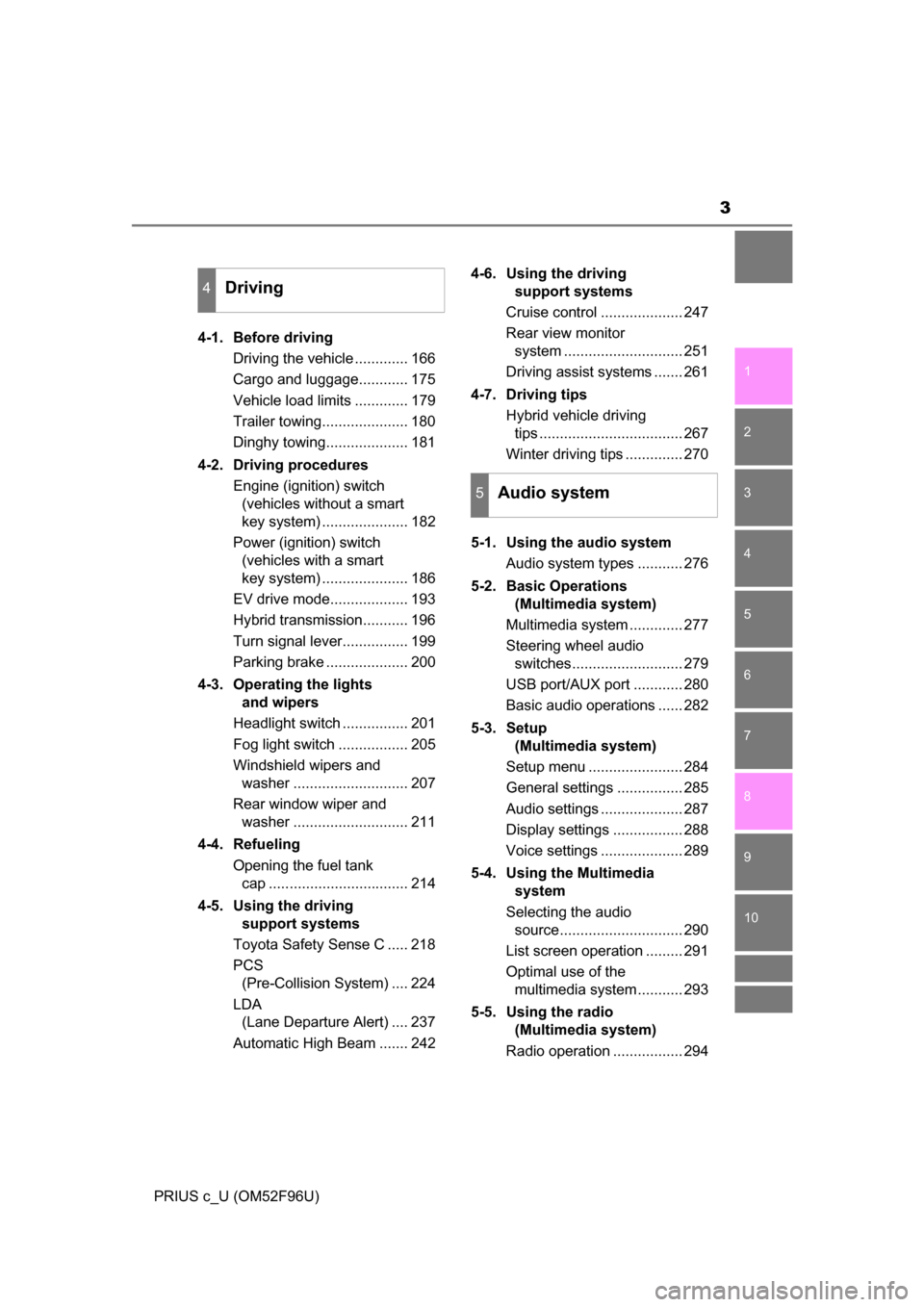
3
1
9 8 6 5
4
3
2
PRIUS c_U (OM52F96U)
10
7
4-1. Before drivingDriving the vehicle ............. 166
Cargo and luggage............ 175
Vehicle load limits ............. 179
Trailer towing..................... 180
Dinghy towing.................... 181
4-2. Driving procedures Engine (ignition) switch (vehicles without a smart
key system) ..................... 182
Power (ignition) switch (vehicles with a smart
key system) ..................... 186
EV drive mode................... 193
Hybrid transmission........... 196
Turn signal lever................ 199
Parking brake .................... 200
4-3. Operating the lights and wipers
Headlight switch ................ 201
Fog light switch ................. 205
Windshield wipers and washer ............................ 207
Rear window wiper and washer ............................ 211
4-4. Refueling Opening the fuel tank cap .................................. 214
4-5. Using the driving support systems
Toyota Safety Sense C ..... 218
PCS (Pre-Collision System) .... 224
LDA (Lane Departure Alert) .... 237
Automatic High Beam ....... 242 4-6. Using the driving
support systems
Cruise control .................... 247
Rear view monitor system ............................. 251
Driving assist systems ....... 261
4-7. Driving tips Hybrid vehicle driving tips ................................... 267
Winter driving tips .............. 270
5-1. Using the audio system Audio system types ........... 276
5-2. Basic Operations (Multimedia system)
Multimedia system ............. 277
Steering wheel audio switches........................... 279
USB port/AUX port ............ 280
Basic audio operations ...... 282
5-3. Setup (Multimedia system)
Setup menu ....................... 284
General settings ................ 285
Audio settings .................... 287
Display settings ................. 288
Voice settings .................... 289
5-4. Using the Multimedia system
Selecting the audio source.............................. 290
List screen operation ......... 291
Optimal use of the multimedia system........... 293
5-5. Using the radio (Multimedia system)
Radio operation ................. 294
4Driving
5Audio system
Page 18 of 588
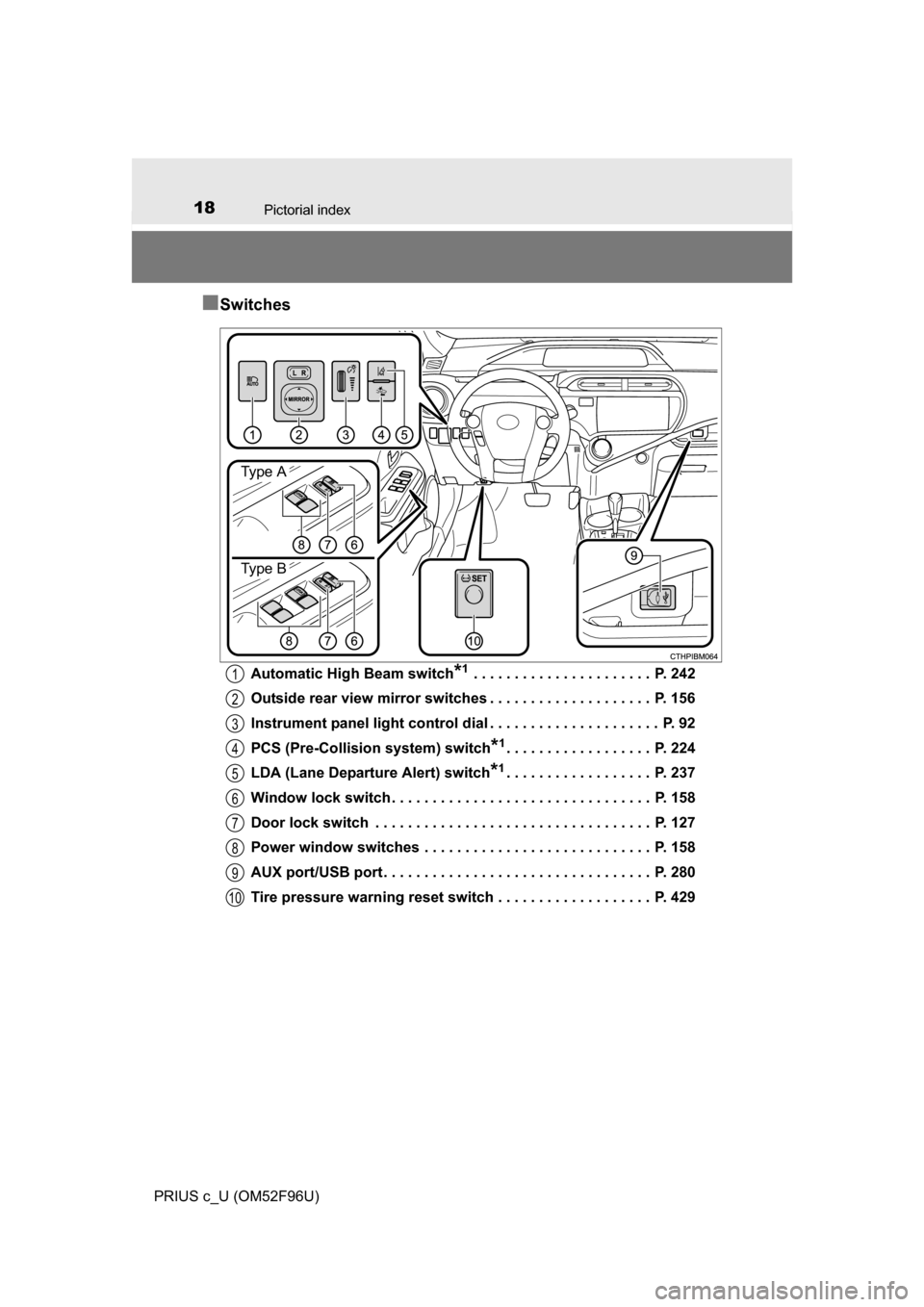
18Pictorial index
PRIUS c_U (OM52F96U)
■Switches
Automatic High Beam switch*1 . . . . . . . . . . . . . . . . . . . . . . P. 242
Outside rear view mirror switches . . . . . . . . . . . . . . . . . . . . P. 156
Instrument panel light control dial . . . . . . . . . . . . . . . . . . . . . P. 92
PCS (Pre-Collision system) switch
*1. . . . . . . . . . . . . . . . . . P. 224
LDA (Lane Departure Alert) switch
*1. . . . . . . . . . . . . . . . . . P. 237
Window lock switch . . . . . . . . . . . . . . . . . . . . . . . . . . . . . . . . P. 158
Door lock switch . . . . . . . . . . . . . . . . . . . . . . . . . . . . . . . . . . P. 127
Power window switches . . . . . . . . . . . . . . . . . . . . . . . . . . . . P. 158
AUX port/USB port . . . . . . . . . . . . . . . . . . . . . . . . . . . . . . . . . P. 280
Tire pressure warning reset switch . . . . . . . . . . . . . . . . . . . P. 429
Type A
Type B
1
2
3
4
5
6
7
8
9
10
Page 89 of 588
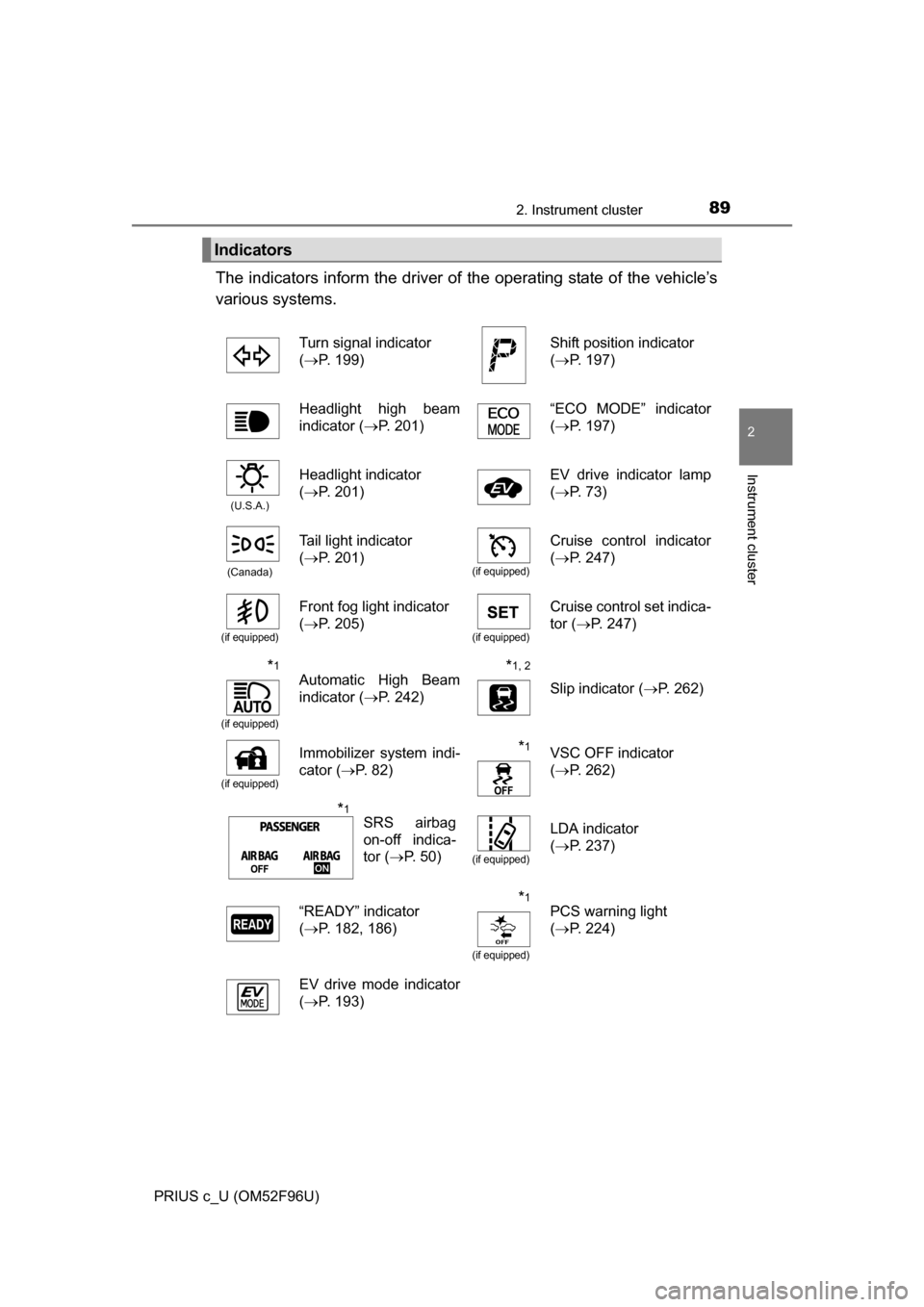
892. Instrument cluster
2
Instrument cluster
PRIUS c_U (OM52F96U)
The indicators inform the driver of the operating state of the vehicle’s
various systems.
Indicators
Turn signal indicator
( P. 199)Shift position indicator
(P. 197)
Headlight high beam
indicator ( P. 201) “ECO MODE” indicator
(
P. 197)
(U.S.A.)
Headlight indicator
(P. 201)EV drive indicator lamp
(P. 73)
(Canada)
Tail light indicator
(P. 201)
(if equipped)
Cruise control indicator
(P. 247)
(if equipped)
Front fog light indicator
(P. 205)
(if equipped)
Cruise control set indica-
tor ( P. 247)
*1
(if equipped)
Automatic High Beam
indicator ( P. 242)*1, 2
Slip indicator ( P. 262)
(if equipped)
Immobilizer system indi-
cator (P. 82)*1VSC OFF indicator
(P. 262)
(if equipped)
LDA indicator
(P. 237)
“READY” indicator
( P. 182, 186)
*1
(if equipped)
PCS warning light
(P. 224)
EV drive mode indicator
( P. 193)
SRS airbag
on-off indica-
tor ( P. 50)*1
Page 165 of 588
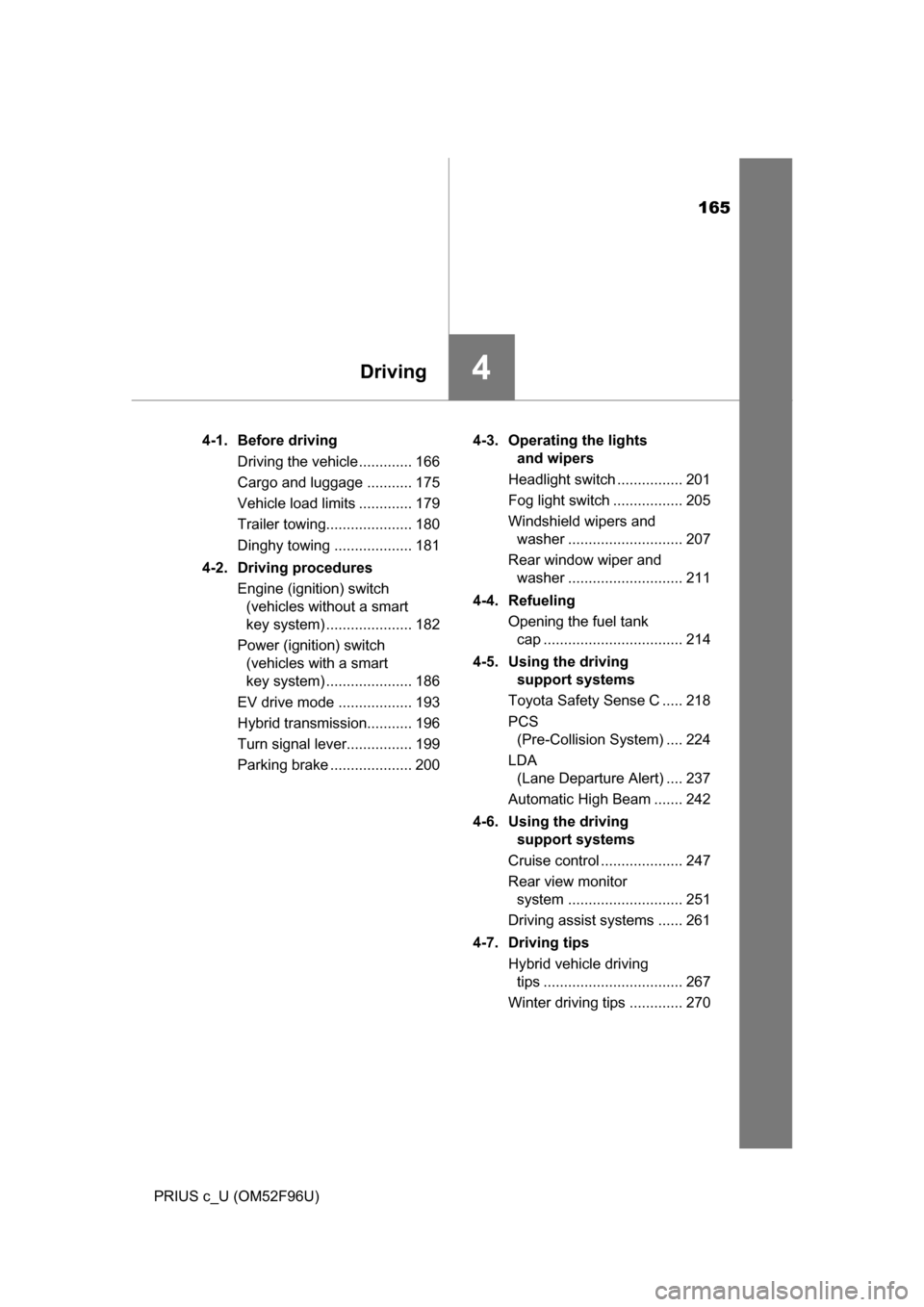
165
4Driving
PRIUS c_U (OM52F96U)4-1. Before driving
Driving the vehicle ............. 166
Cargo and luggage ........... 175
Vehicle load limits ............. 179
Trailer towing..................... 180
Dinghy towing ................... 181
4-2. Driving procedures Engine (ignition) switch (vehicles without a smart
key system) ..................... 182
Power (ignition) switch (vehicles with a smart
key system) ..................... 186
EV drive mode .................. 193
Hybrid transmission........... 196
Turn signal lever................ 199
Parking brake .................... 200 4-3. Operating the lights
and wipers
Headlight switch ................ 201
Fog light switch ................. 205
Windshield wipers and washer ............................ 207
Rear window wiper and washer ............................ 211
4-4. Refueling Opening the fuel tank cap .................................. 214
4-5. Using the driving support systems
Toyota Safety Sense C ..... 218
PCS (Pre-Collision System) .... 224
LDA (Lane Departure Alert) .... 237
Automatic High Beam ....... 242
4-6. Using the driving support systems
Cruise control .................... 247
Rear view monitor system ............................ 251
Driving assist systems ...... 261
4-7. Driving tips Hybrid vehicle driving tips .................................. 267
Winter driving tips ............. 270
Page 202 of 588
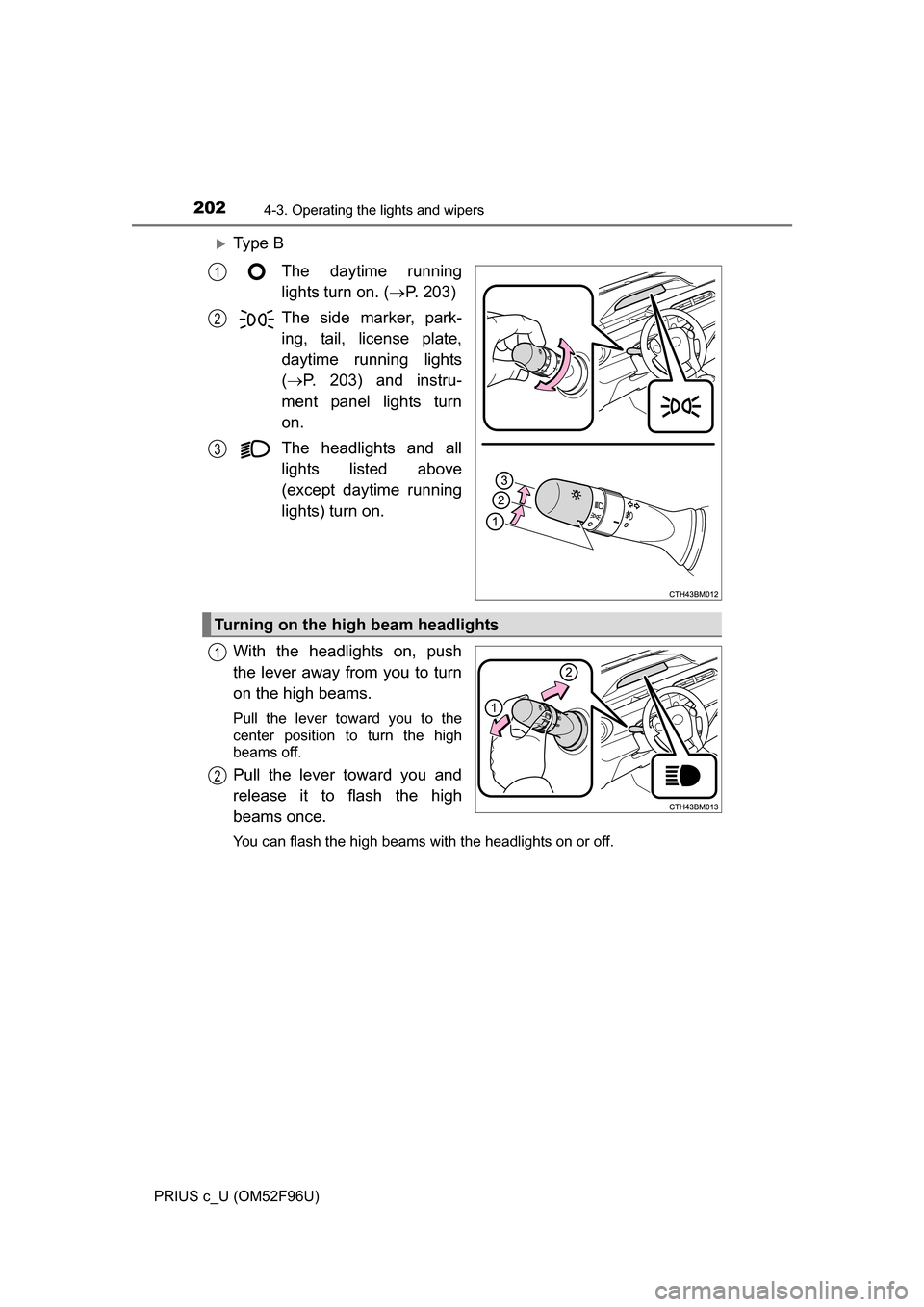
2024-3. Operating the lights and wipers
PRIUS c_U (OM52F96U)
Ty p e BThe daytime running
lights turn on. ( P. 203)
The side marker, park-
ing, tail, license plate,
daytime running lights
( P. 203) and instru-
ment panel lights turn
on.
The headlights and all
lights listed above
(except daytime running
lights) turn on.
With the headlights on, push
the lever away from you to turn
on the high beams.
Pull the lever toward you to the
center position to turn the high
beams off.
Pull the lever toward you and
release it to flash the high
beams once.
You can flash the high beams with the headlights on or off.
1
2
3
Turning on the high beam headlights
1
2
Page 218 of 588
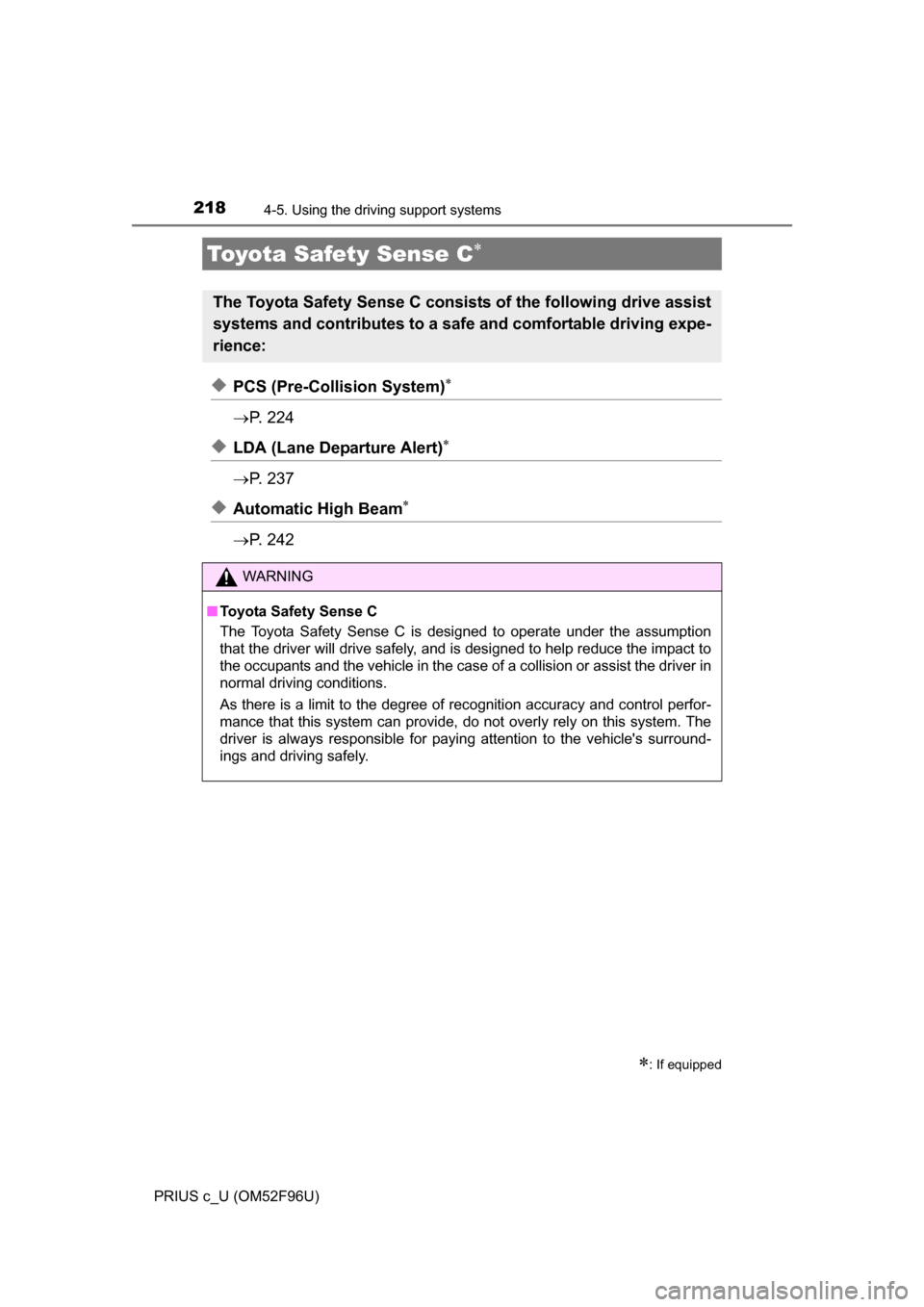
218
PRIUS c_U (OM52F96U)
4-5. Using the driving support systems
◆PCS (Pre-Collision System)
P. 2 2 4
◆LDA (Lane Departure Alert)
P. 2 3 7
◆Automatic High Beam
P. 2 4 2
Toyota Safety Sense C
: If equipped
The Toyota Safety Sense C consis ts of the following drive assist
systems and contributes to a safe and comfortable driving expe-
rience:
WARNING
■ Toyota Safety Sense C
The Toyota Safety Sense C is designed to operate under the assumption
that the driver will drive safely, and is designed to help reduce the impact to
the occupants and the vehicle in the case of a collision or assist the driver in
normal driving conditions.
As there is a limit to the degree of recognition accuracy and control perfor-
mance that this system can provide, do not overly rely on this system. The
driver is always responsible for paying attention to the vehicle's surround-
ings and driving safely.
Page 242 of 588
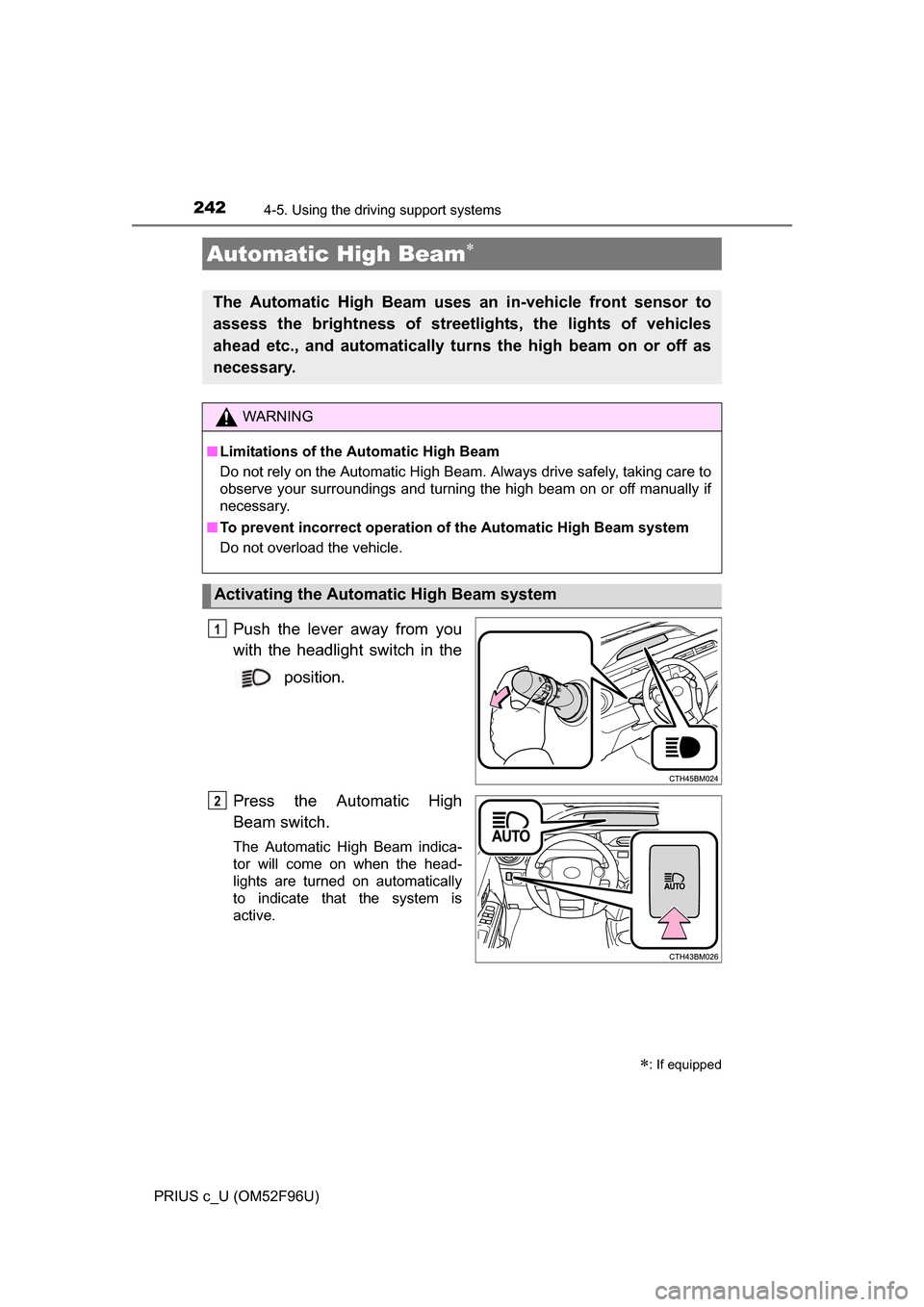
2424-5. Using the driving support systems
PRIUS c_U (OM52F96U)
Push the lever away from you
with the headlight switch in the
position.
Press the Automatic High
Beam switch.
The Automatic High Beam indica-
tor will come on when the head-
lights are turned on automatically
to indicate that the system is
active.
Automatic High Beam
: If equipped
The Automatic High Beam uses an in-vehicle front sensor to
assess the brightness of streetlights, the lights of vehicles
ahead etc., and automatically turns the high beam on or off as
necessary.
WARNING
■ Limitations of the Automatic High Beam
Do not rely on the Automatic High Beam. Always drive safely, taking care to
observe your surroundings and turning the high beam on or off manually if
necessary.
■ To prevent incorrect operation of the Automatic High Beam system
Do not overload the vehicle.
Activating the Automatic High Beam system
1
2
Page 243 of 588
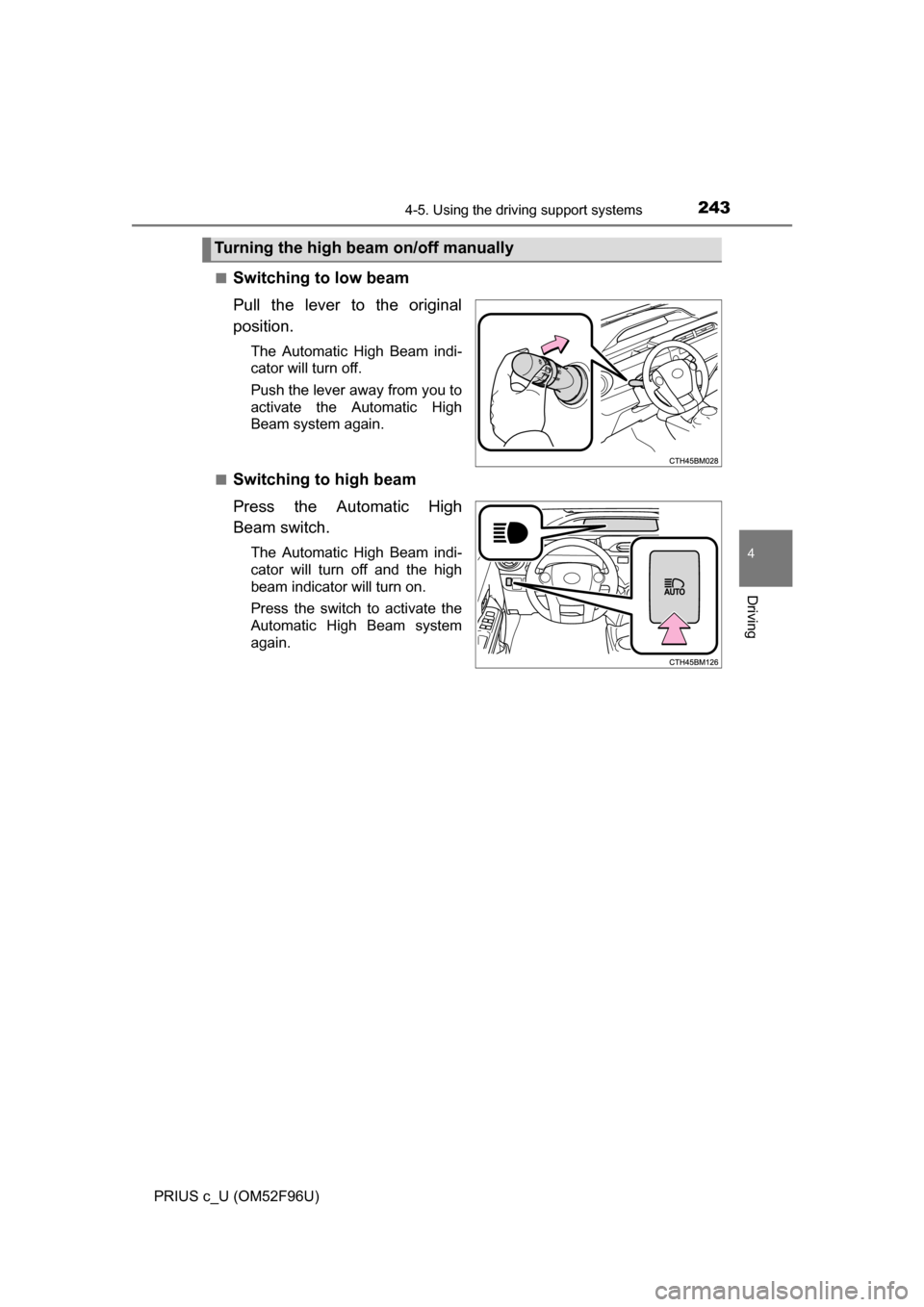
2434-5. Using the driving support systems
4
Driving
PRIUS c_U (OM52F96U)■
Switching to low beam
Pull the lever to the original
position.
The Automatic High Beam indi-
cator will turn off.
Push the lever away from you to
activate the Automatic High
Beam system again.
■
Switching to high beam
Press the Automatic High
Beam switch.
The Automatic High Beam indi-
cator will turn off and the high
beam indicator will turn on.
Press the switch to activate the
Automatic High Beam system
again.
Turning the high beam on/off manually
Page 244 of 588
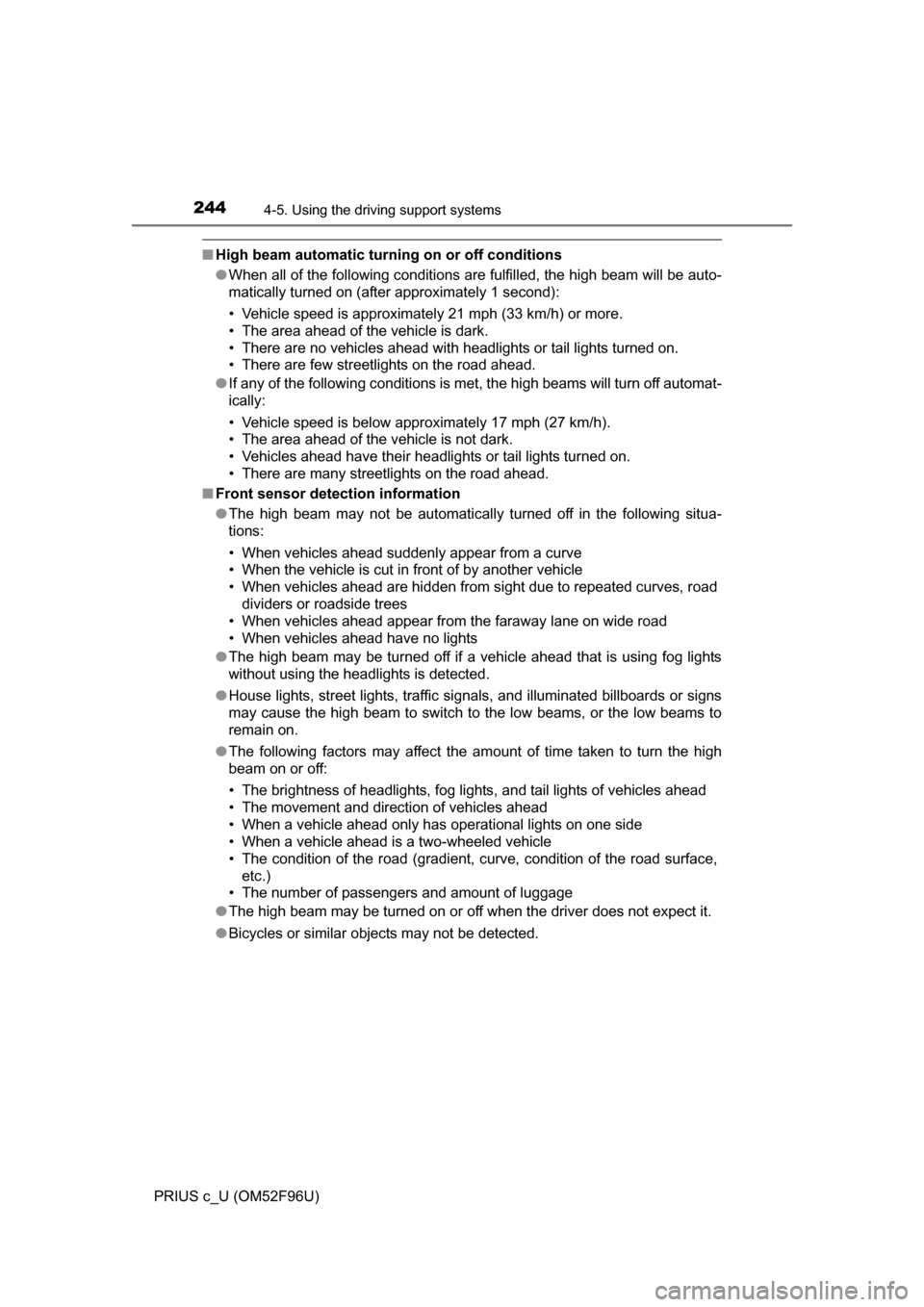
2444-5. Using the driving support systems
PRIUS c_U (OM52F96U)
■High beam automatic turning on or off conditions
●When all of the following conditions are fulfilled, the high beam will be auto-
matically turned on (after approximately 1 second):
• Vehicle speed is approximately 21 mph (33 km/h) or more.
• The area ahead of the vehicle is dark.
• There are no vehicles ahead with headlights or tail lights turned on.
• There are few streetlights on the road ahead.
● If any of the following conditions is met, the high beams will turn off automat-
ically:
• Vehicle speed is below approx imately 17 mph (27 km/h).
• The area ahead of the vehicle is not dark.
• Vehicles ahead have their headlights or tail lights turned on.
• There are many streetlights on the road ahead.
■ Front sensor detection information
●The high beam may not be automatically turned off in the following situa-
tions:
• When vehicles ahead suddenly appear from a curve
• When the vehicle is cut in front of by another vehicle
• When vehicles ahead are hidden from sight due to repeated curves, road
dividers or roadside trees
• When vehicles ahead appear from the faraway lane on wide road
• When vehicles ahead have no lights
● The high beam may be turned off if a vehicle ahead that is using fog lights
without using the headlights is detected.
● House lights, street lights, traffic signals, and illuminated billboards or signs
may cause the high beam to switch to the low beams, or the low beams to
remain on.
● The following factors may affect the amount of time taken to turn the high
beam on or off:
• The brightness of headlights, fog lights, and tail lights of vehicles ahead
• The movement and direction of vehicles ahead
• When a vehicle ahead only has operational lights on one side
• When a vehicle ahead is a two-wheeled vehicle
• The condition of the road (gradient, curve, condition of the road surface,
etc.)
• The number of passengers and amount of luggage
● The high beam may be turned on or off when the driver does not expect it.
● Bicycles or similar objects may not be detected.
Page 245 of 588
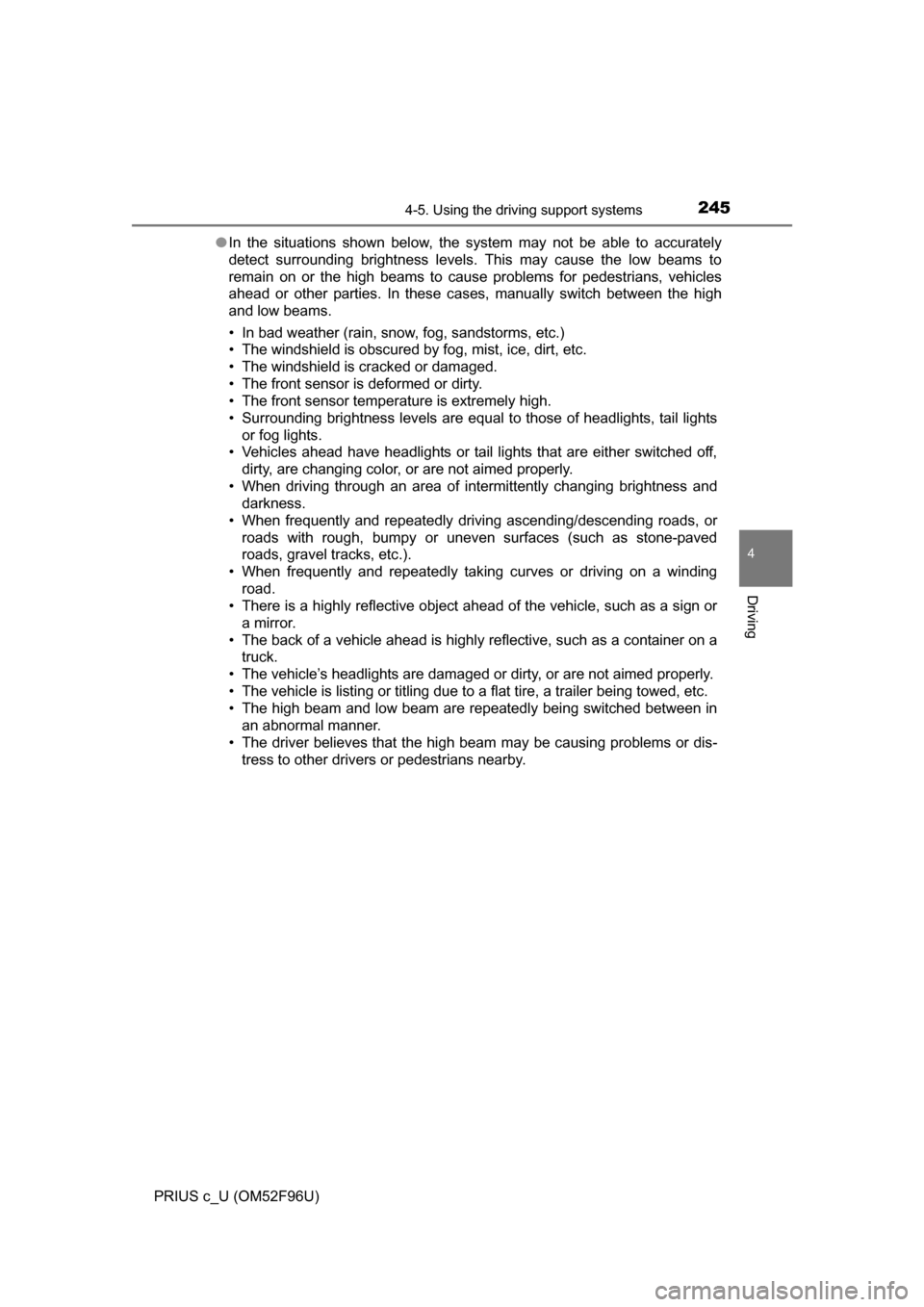
2454-5. Using the driving support systems
4
Driving
PRIUS c_U (OM52F96U)●
In the situations shown below, the system may not be able to accurately
detect surrounding brightness levels. This may cause the low beams to
remain on or the high beams to cause problems for pedestrians, vehicles
ahead or other parties. In these cases, manually switch between the high
and low beams.
• In bad weather (rain, snow, fog, sandstorms, etc.)
• The windshield is obscured by fog, mist, ice, dirt, etc.
• The windshield is cracked or damaged.
• The front sensor is deformed or dirty.
• The front sensor temperature is extremely high.
• Surrounding brightness levels are equal to those of headlights, tail lights
or fog lights.
• Vehicles ahead have headlights or tail lights that are either switched off,
dirty, are changing color, or are not aimed properly.
• When driving through an area of in termittently changing brightness and
darkness.
• When frequently and repeatedly driving ascending/descending roads, or roads with rough, bumpy or uneven surfaces (such as stone-paved
roads, gravel tracks, etc.).
• When frequently and repeatedly taking curves or driving on a winding road.
• There is a highly reflective object ahead of the vehicle, such as a sign or
a mirror.
• The back of a vehicle ahead is highly reflective, such as a container on a truck.
• The vehicle’s headlights are damaged or dirty, or are not aimed properly.
• The vehicle is listing or titling due to a flat tire, a trailer being towed, etc.
• The high beam and low beam are repeatedly being switched between in an abnormal manner.
• The driver believes that the high beam may be causing problems or dis-
tress to other drivers or pedestrians nearby.